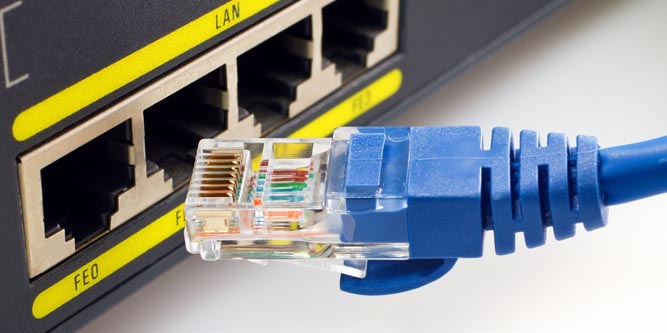If you’re trying to set up a new home network, there are two cable choices: Category 5 and Category 6. These are commonly abbreviated as Cat5 and Cat6. So, why are there only these two? And what’s the difference between the two? We’re about to take a close look at Ethernet cable technology, and what separates Cat5 from Cat6. Then, it will be up to you to decide. Let’s get started!
Ethernet Basics
If this is your first time buying Ethernet cable, it may surprise you to know that there are two types of cable. Isn’t Ethernet all the same? In fact, Ethernet is an evolving standard that’s been around since the late 1970s. However, it first saw practical use in 1980, and was standardized in 1983. Back in those rates, an Ethernet signal ran over a coaxial cable, like your cable line. These early Ethernet cables had a maximum transfer rate of 2.94Mbps. That’s less than one percent the transfer rate of even older USB 2.0 cables. Modern Ethernet cables, however, are much faster. At the very high end, they can transfer as much as 40Gbps. These ultra-fast cables, though, are only found in commercial applications. Most home Ethernet cables now offer 1Gbps (“gigabit”) speeds.
Coaxial cable is notorious for rapid signal degradation. This means that the signal will get weaker quickly over long distances. The first step to getting better speeds was to add signal boosters into the network. These signal boosters were called “repeaters,” and allowed for virtually unlimited wire runs. However, early repeaters still had a significant disadvantage. They only had two ports! This was useless for networking, since you could only connect two devices to each-other. Shortly thereafter, repeaters with multiple ports became available. This made it possible to connect multiple devices into a single local network.
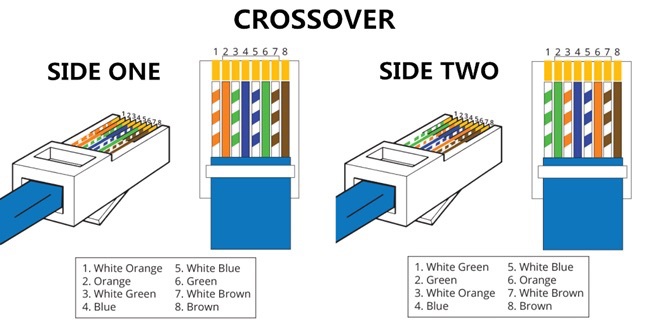
In 1987, a company called SynOptics produced the next major advance. Instead of coaxial cable, their new Ethernet cable used a twisted-pair design. Twisted-pair wiring was nothing new. It had been used for telephones for years. The twisted pair of wires reinforced each-others signal, so much longer runs were possible. This stronger signal also reduced the need for shielding, resulting in a slimmer, more lightweight cable. But it wasn’t suitable for the types of speeds people were getting from Ethernet. SynOptics had fixed that problem, and produced a twisted-pair Ethernet cable capable of 10Mbps transfer rates.
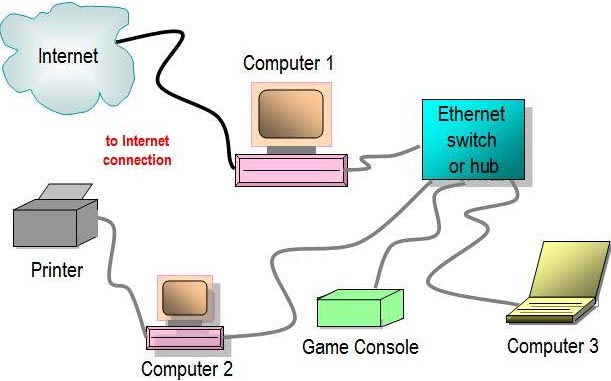
Along with this new cabling, SynOptics also introduced hub technology. These hubs were similar to the multi-port repeaters used on coaxial Ethernet. They weren’t required for signal-boosting, but they made it easy to network multiple devices. Later improvements by Motorola and others allowed for more advanced hubs called switches. It’s not a far leap from these switches to the slick wireless routers we use today.
What do Cat5 and Cat6 Mean?
Strictly speaking, Category 5 and Category 6 aren’t only Ethernet cables. They’re also a standard for twisted-wire cable, which, as we mentioned, has been around for a while. The earliest standard, called Category 1, was the standard in residential phone wiring for years. It’s ordinary, thin, landline phone wire with two pairs of twisted wires inside. In the early days of the internet, it was used for home access when necessary. However, it was never used for any sort of serious networking infrastructure. As a result, Category 1 is just a type of twisted-wire cable, not a type of Ethernet.
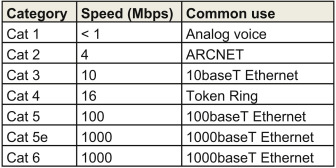
Category 2 cable is a beefier type of cable that uses four pairs of wires instead of two pairs. As a result, it can handle twice as much data. It was never an Ethernet standard. However, it’s worth mentioning because it was used in some early networks that did not use Ethernet. It was also used in larger telephone networks. But with the development of newer, more advanced standards, Category 2 is now rarely used.
Category 3 cable is the first twisted wire cable standard that’s also a type of Ethernet cable. It’s the cable SynOptics Developed, with the transfer rate of 10Mbps. At the time, this was considered blazing fast, and Cat 3 became the standard from 1987 until the late 90s. However, technology eventually advanced to the point where 10Mbps was no longer fast enough. High-speed internet had arrived, and people needed more speed.
Category 4 is a bit of an oddball. First released in 1996, it used four wire pairs to provide speeds of up to 16Mbps. This was 60 percent faster than Category 3, and seemed like a surefire hit. However, by the time it was starting to catch on, it was already being superseded by Category 5.
What is Cat5e?
Category 5 cable was first released in 1999. However, most people use the modern variant, Category 5 Enhanced, released in 2001. Category 5 Enhanced cable, usually called Cat5e, is a significantly more powerful standard than Category 3 or 4. Instead of 10 or 16Mbps, it offers transfer rates of up to 1,000Mbps, or 1Gbps. For this reason, it’s often called “Gigabit” Ethernet. Built with 24-gauge wires, it can support runs of up to 330 feet without a switch or a booster. These heavier wires are also what allows it to offer higher speeds without adding more contacts to the tip. As a result, Cat5e cables are compatible with older, Category 3 architecture.
Needless to say, Cat5e took the technology world by storm, and quickly became the new standard. In fact, many institutional maintenance plans require all old Category 3 cable to be replaced with Cat5e. Cat5e has allowed us to enjoy the modern, high-speed internet we know and love. For instance, it can be used to transmit HD video. Gigabit Ethernet has given us streaming services like Netflix and Hulu, among other major benefits.
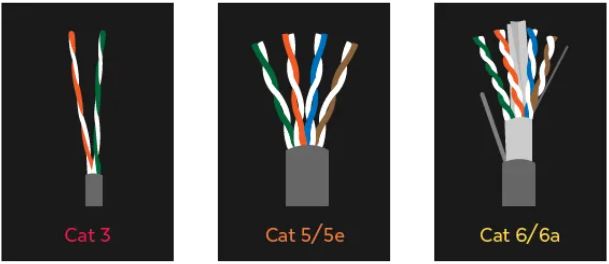
What is Cat6a?
Category 6 (Cat6a) was released just a few years after Cat5e. Like Cat5e, it uses the same tips as Category 3, so it’s backwards-compatible with older hardware. Also like Cat5e, it supports 330-foot runs at Gigabit speeds. The difference is that it’s a beefier cable, with significantly improved shielding and insulation. It’s traditionally been used for lines in the backbone of a facility, where lots of cables are bundled together. In that situation, the better shielding provides a better signal. Furthermore, Cat6a cable can be used for shorter runs at 10Gbps speeds. This isn’t much use in your home, but it’s essential for commercial applications.
That said, Cat6a can be useful for homeowners and small businesses for one application. Because of its insulated design, it’s better-suited for transmitting power. For many people, that’s not going to do much. But if you want to use a PoE device like a security system, you’ll want to use Cat6a cable. Keep in mind, though, that most routers and switches don’t provide power. To make your system work, you’ll need power injectors and PoE injection adapters.
Are There Other Options?
Before we conclude, you might be wondering whether there are even more categories of Ethernet cable. In fact, there are two. Category 7 exists, and offers an even better transfer rate than Cat6. That said, it’s only useful for very short runs. For this reasons, it’s used mostly for commercial patch cables. There’s also a Category 8, which is only just starting to get produced. It’s a shielded version of Category 7, which allows for even higher transfer rates. Similar to Category 7, it’s only really used for very short runs in commercial applications. There’s no (current) practical use for these types of Ethernet in your home network.
What’s the Difference?
As you can see, Ethernet cables have been upgraded several times over the years. Knowing which version is right for you is ideal. Category 3 had an admirable run, but it’s just not suitable for today’s networks. Similarly, Categories 7 and 8 are way more than you’d ever need at home, and too pricey. For 99 percent of people, Cat5e and Cat6a are going to be your best choice.
In terms of speed, there are very few practical differences for home use. If you live under a set of power lines, you might want to use Cat6a for the added shielding. But most people aren’t going to notice any significant difference in a home application. For businesses, Cat6a can be more useful. For example, if your business uses a faster-than-Gigabit connection, it can run from the modem to the router. Moreover, it can also be safely used in environments like a recording studio, where shielding is essential. For similar reasons, Cat6a is safer to use around sensitive medical equipment. Basically, any time there are very sensitive electronics nearby, Cat6a is a good idea.
Another good reason to use Cat6a is if you have PoE devices around your house. PoE technology has only recently started becoming popular with the general public. However, if you think you might use PoE devices in the future, wire your house with Cat6a. That way, you won’t have to worry about re-wiring the whole house later.
Meet Ry, “TechGuru,” a 36-year-old technology enthusiast with a deep passion for tech innovations. With extensive experience, he specializes in gaming hardware and software, and has expertise in gadgets, custom PCs, and audio.
Besides writing about tech and reviewing new products, he enjoys traveling, hiking, and photography. Committed to keeping up with the latest industry trends, he aims to guide readers in making informed tech decisions.

